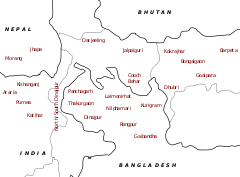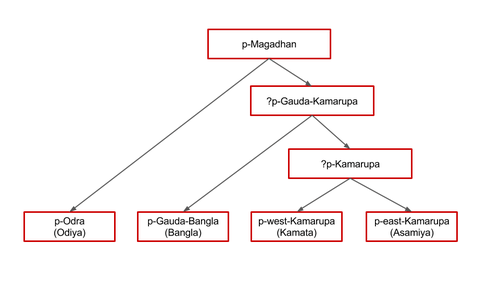KRNB lects
KRNB lects (or Kamta, Rajbanshi and Northern Bangla lects) are modern lects that arose from the proto-Kamata language. The proto-Kamata language began differentiating after 1250 around Kamatapur, the capital city of Kamata kingdom, as the western branch of the proto-Kamarupa, whereas the eastern branch developed into proto-Assamese, which finally yielded the modern Assamese language. Kamrupi is today one of the western dialects of Assamese.[2] Kamatapuri is represented by group of modern lects,[3][4] termed variously Kamtapuri (West Bengal), Rangpuri (Bangladesh), Rajbanshi (West Bengal) and Surjapuri (Bihar).[5]


| KRNB lects | |
|---|---|
| Kamatapuri lects | |
| Native to | India, Bangladesh, Nepal |
| Region | Northern West Bengal, Western Assam, North Eastern Bihar, Northern Bangladesh, Southeast Nepal |
Indo-European
| |
| Dialects | Rajbansi, Kamtapuri, Rangpuri, Deshi, Surjapuri, Dhekri |
| Language codes | |
| ISO 639-3 | – |
| Glottolog | None |
Origin
The development of proto-Kamta was the result of Sandhya, a ruler of Kamarupanagara (North Guwahati), Kamrup moving his capital[8][9] to Kamatapur and establishing the Kamata kingdom, thus carrying the native language along with.
Region
The modern KRNB lects are spoken primarily in western Assam, northern West Bengal, northern Bangladesh, north-eastern Bihar and south-eastern Nepal.[5]
Notes
- Toulmin 2006
- Toulmin, Mathew W S (2006), Reconstructing linguistic history in a dialect continuum: The Kamta, Rajbanshi, and Northern Deshi Bangla subgroup of Indo-Aryan (Ph.D.), Australian National University, p. 14: "Kamrupa: Chatterjee (1926) uses this term to refer to the stage of linguistic history ancestral to both Asamiya and KRNB. In the present study, Kamrupa is used with the same meaning, and is not considered synonymous with KRNB which is a further development (cf. section 7.3.4. N. Das (2001) maintains that 'Kamrupa' or 'Kamrupi' is a more fitting title than 'Kamta' for KRNB varieties. However, the term 'Kamrupi' is most popularly used today to denote the western dialect of Asamiya spoken in the greater Kamrup region of Assam (cf. Goswami 1970). It seems well fitted to denote both (1) the modern lect of the greater Kamrup region of Western Assam (east of the KRNB area), as well as (2) the historical lect ancestral to both KRNB and Asamiya. In this study I refer to the western dialect of Asamiya as Kamrupi, and the historical ancestor of proto-Kamata and proto-Asamiya as proto-Kamrupa."
- (Toulmin 2006, p. iv)
- (Toulmin 2006, p. 283)
- Hernández-Campoy, Juan Manuel; Conde-Silvestre, Juan Camilo (2012-02-15). The Handbook of Historical Sociolinguistics. ISBN 9781118257265.
- (Toulmin 2006, p. 5)
- Proto-Kamta took its inheritance from ?proto-Kamarupa (and before that from ?proto-Gauda-Kamarupa), innovated the unique features ... in 1250-1550 AD" (Toulmin 2006:306)
- Toulmin, Mathew W S (2006), Reconstructing linguistic history in a dialect continuum: The Kamta, Rajbanshi, and Northern Deshi Bangla subgroup of Indo-Aryan (Ph.D.), p.8, The Australian National University Morphological reconstructions in chapter 5-6 provides diagonastic evidence for a common historical stage to the 8 KRNB lects examined in those chapter. On sociohistorical grounds, this stage is termed 'proto-Kamta' in chapter 7 and assigned the chronology of c1250-1550-sandwitched between the establishment of the Kamarupa capital at Kamatapur in 1250 AD and the political (plausibly linguistic) expansion under Koch king Nara Narayan in 1550 AD.
- (Toulmin 2006, p. 282)
References
- Toulmin, Mathew W S (2006). Reconstructing linguistic history in a dialect continuum: The Kamta, Rajbanshi, and Northern Deshi Bangla subgroup of Indo-Aryan (Ph.D.). The Australian National University.CS1 maint: ref=harv (link)